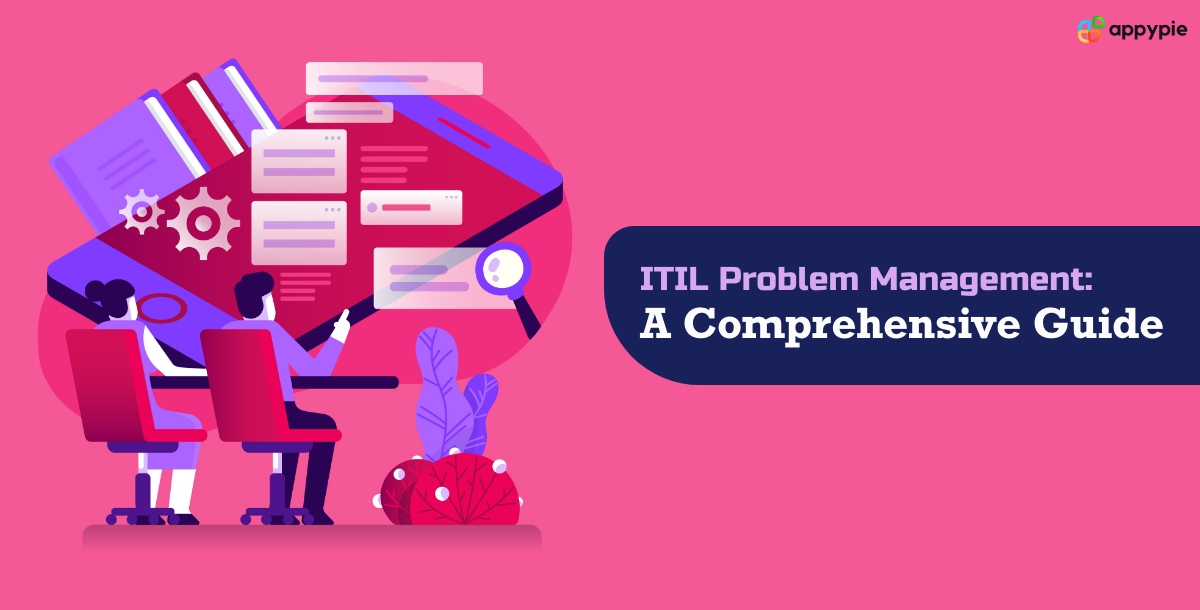ITIL Problem Management: A Comprehensive Guide

Imagine an IT environment where recurring issues are a thing of the past. Instead of constantly firefighting incidents, your team can focus on proactive initiatives that drive business growth. This is the power of Information Technology Infrastructure Library (ITIL) problem management.
This comprehensive guide dives deep into ITIL problem management, exploring everything you need to know. We'll cover its definition, objectives, the different types of problems you might encounter, and why it's crucial for any IT service management (ITSM) system. We'll also unveil the core processes involved, showcase real-world examples, and highlight the benefits of utilizing ITIL problem management software.
By the end of this blog, you'll be equipped to implement a robust problem management strategy that ensures long-term IT stability and empowers your team to deliver exceptional service. Let's embark on this journey towards a proactive and efficient IT environment!
Table of Contents
- What Is ITIL Problem Management?
- Key Objectives Of ITIL Problem Management
- Types of ITIL Problem Management
- Importance of ITIL Problem Management In A Business
- ITIL Problem Management Process: A Step-by-Step Guide
- Bringing ITIL Problem Management to Life: Real-World Examples
- The ITIL Problem Management Toolkit: Empowering Your Team for Success
- In Summary
What Is ITIL Problem Management?
ITIL problem management is the secret weapon within your IT service management (ITSM) system. It's a structured approach to tackling the root cause of incidents, preventing them from becoming recurring headaches for your IT team and users.
Instead of simply patching temporary fixes, problem management delves deeper to identify the underlying issues causing those incidents. This proactive approach involves:
- Investigating the root cause: Uncovering the source of the problem, not just the symptoms.
- Developing a permanent solution: Implementing long-term fixes that eliminate the problem entirely.
- Preventing future occurrences: Taking proactive steps to minimize the risk of the problem re-emerging.
By focusing on the root cause, ITIL problem management helps organizations achieve long-term IT stability and improve the overall effectiveness of their ITSM system.
Key Objectives Of ITIL Problem Management

ITIL problem management isn't just about fixing problems; it's about preventing them altogether. This proactive approach is driven by three core objectives, often summarized by the acronym PDM:
- Prevention: The ultimate goal is to minimize incidents before they even occur. By analyzing incident trends and known errors within IT ticketing systems, problem management identifies potential issues and implements preventative measures. This proactive approach translates to fewer headaches for your IT team and a more stable IT environment.
- Detection: Acting as a detective for your IT infrastructure, problem management actively seeks out the root causes of incidents. This involves analyzing incident patterns and leveraging data from help desk software to pinpoint the underlying problems that are causing disruptions. Early detection allows for faster resolution and minimizes the impact on users.
- Management: Once a problem is identified, it's time for action. Problem management takes ownership, prioritizing issues based on their potential impact and ensuring they're resolved effectively. This often involves collaboration with other teams to implement appropriate solutions and ensure long-term stability.
Also Read:How AI-Powered Ticketing System Can Revolutionize Your IT Support
By focusing on PDM, IT problem management empowers organizations to move beyond reactive firefighting and build a more proactive and efficient IT environment.
Types of ITIL Problem Management
ITIL problem management isn't a one-size-fits-all approach. It encompasses a three-pronged strategy to tackle IT issues, each with its own distinct strengths:
- Reactive Problem Management: Addressing the Here and Now
- Identify the Root Cause: The detective work begins, uncovering the underlying source of the incident, not just the symptoms.
- Implement a Workaround: A temporary solution is put in place to restore functionality as quickly as possible. This might involve a workaround or a configuration change.
- Prevent Recurrence: Drawing on the identified root cause, measures are implemented to minimize the risk of the problem re-emerging. This could involve permanent solution development or integrating preventative steps into your IT management software.
- Proactive Problem Management: Stopping Problems Before They Start
- Analyze Incident Data: Identify recurring themes and patterns within incident reports to pinpoint potential weaknesses in your IT infrastructure.
- Predict and Prevent: Armed with these insights, proactive measures can be implemented to address potential problems before they cause disruptions. This could involve system upgrades, configuration adjustments, or preventative maintenance schedules.
- Continuous Problem Management: A Commitment to Improvement
- Regular Review: Metrics and processes are regularly evaluated to assess the effectiveness of your problem management strategy.
- Identifying Improvement Areas: No system is perfect. This step focuses on pinpointing areas where problem management can be strengthened.
- Taking Corrective Action: Based on the review, actions are implemented to fine-tune your problem management processes and ensure they remain effective in the ever-evolving IT landscape.
This approach focuses on resolving problems that have already caused disruptions, often identified through reports within IT ticketing systems. It involves a rapid response to:
This proactive approach takes problem management to the next level. By analyzing trends, patterns, and known errors, it aims to identify potential issues before they erupt into full-blown incidents. IT problem management software plays a crucial role here, allowing you to:
ITIL problem management is an ongoing process, not a one-time fix. Continuous problem management ensures your organization is constantly learning and improving its approach. This involves:
By adopting these three pillars of ITIL problem management, organizations can build a robust and proactive approach to IT service delivery. This translates to fewer disruptions, a more stable IT environment, and ultimately, happier users.
Importance of ITIL Problem Management In A Business
Effective ITIL problem management offers several benefits to businesses like:
- Reduced Business Impact
- Improved Customer Satisfaction
- Cost Savings
- Enhanced Learning and Growth
- Better Resource Utilization

Imagine minimizing the disruptions caused by IT incidents. ITIL problem management achieves this by focusing on the root cause, not just the symptoms. By proactively identifying and addressing these underlying issues, you can significantly reduce downtime, improve service availability, and ensure your business operations run smoothly. This translates to increased productivity, happier employees, and ultimately, a stronger competitive edge.

Recurring IT issues can quickly erode customer satisfaction. Problem management tackles this head-on by permanently resolving the root causes behind these frustrating incidents. This not only minimizes disruptions but also demonstrates your commitment to providing a reliable and consistent service. By boosting customer satisfaction, you can foster loyalty and build stronger relationships with your customer base.

Constantly battling reactive incident management can be a financial drain. ITIL problem management offers a cost-effective solution by taking a proactive approach. By preventing incidents from happening in the first place, you can significantly reduce the overall cost of incident management. This frees up valuable resources for more strategic initiatives, allowing you to invest in innovation and growth.

ITIL problem management fosters a culture of continuous improvement within your IT organization. Through the process of identifying and resolving problems, a valuable knowledge base of known errors and their solutions is established. This knowledge can be captured and stored within knowledge base software, making it readily accessible to your IT staff. This not only streamlines future problem-solving but also empowers your team to develop their skills and expertise, leading to a more mature and efficient IT service management process.

Picture your IT team spending less time firefighting incidents and more time on strategic projects. This is the power of ITIL problem management. By minimizing the number of incidents, you can optimize the utilization of your IT resources. This frees up your team to focus on high-value activities such as innovation, proactive maintenance, and implementing new technologies. Additionally, consider integrating a customer service chatbot or live chat software to further streamline incident resolution and free up your team to focus on more complex issues.
Related:17 Best Customer Support Software & Apps
By implementing a robust ITIL problem management strategy, businesses can unlock a wealth of benefits, from improved customer satisfaction and cost savings to enhanced learning and growth within their IT organization. It's a strategic investment that pays dividends in the long run, ensuring a stable and efficient IT environment that empowers your business to thrive in the digital age.
ITIL Problem Management Process: A Step-by-Step Guide
ITIL problem management takes a systematic approach to tackling the root causes of IT issues, preventing them from becoming recurring nightmares for your IT team and users. Let's delve into the seven key stages of this process:
- Identification: Unearthing the Root Cause
- Recording: Capturing the Problem Details
- A clear description of the problem
- The potential impact it could have on your business
- Its priority level (how critical is it to fix?)
- Any known workarounds that can temporarily alleviate the issue
- Classification: Prioritizing for Maximum Impact
- Impact: How severely is it disrupting operations?
- Urgency: Does it require immediate attention, or can it wait?
- Potential Root Cause: What might be causing the issue?
- Investigation and Diagnosis: Getting to the Root of the Problem
- Reviewing incident records to gather clues.
- Analyzing system data to identify any anomalies.
- Resolution and Implementation: Eradicating the Problem Once and For All
- Implementing changes to the system or processes.
- Introducing new tools to address the identified weakness.
- Closure: Sealing the Case
- The problem itself
- Its root cause
- The implemented solution
- Review and Improvement: Continuously Striving for Excellence
The detective work begins here! This stage involves analyzing incident records, searching for patterns, and asking the crucial question: "Is there a deeper issue causing these repeated incidents?" By identifying potential underlying problems, your team can address them permanently, preventing future disruptions.
Once a problem is identified, it's essential to document it clearly. This is where a Problem Management Record (PMR) comes in. Think of it as a case file for the problem, containing details like:
Not all problems are created equal. This stage involves classifying the problem based on its:
By classifying the problem, your team can prioritize its resolution effectively, focusing on the most critical issues first.
Now it's time to put on your detective hat and delve deeper. Here, the problem management team investigates the issue to pinpoint its root cause. This might involve:
Employing root cause analysis techniques like the 5 Whys or Fishbone diagrams to ask "why" repeatedly until the underlying cause is revealed.
With the root cause identified, it's time to develop a permanent solution. This could involve:
The key here is to ensure the solution tackles the root cause, not just the symptoms. Once developed, the solution is rigorously tested to confirm its effectiveness.
After successfully implementing the solution and verifying that the problem is truly resolved, the PMR can be closed. This stage also involves documenting the entire process:
This valuable knowledge is then stored in a knowledge base, serving as a reference point for future troubleshooting and ensuring lessons learned are not forgotten.
ITIL problem management is a continuous process, not a one-time fix. The final stage involves reviewing the entire process itself to identify areas for improvement. By regularly evaluating its effectiveness, your organization can ensure the problem management strategy remains efficient and adaptable, constantly evolving to meet the ever-changing IT landscape.
By following these seven stages, organizations can leverage ITIL problem management to build a proactive and robust approach to IT service delivery. This translates to fewer disruptions, a more stable IT environment, and ultimately, a happier and more productive workforce.
Bringing ITIL Problem Management to Life: Real-World Examples
ITIL problem management isn't just theoretical; it's a powerful tool for tackling real-world IT challenges. Here are a few examples that showcase its effectiveness:
- Scenario: The Case of the Disappearing Emails
- Scenario: The Neverending Login Loop
- Scenario: The Phantom Printer Problem
The IT helpdesk is flooded with tickets from employees reporting missing emails. The incident management team quickly springs into action, restarting the email server and restoring functionality. However, the problem management team digs deeper. Through analysis of incident reports and server logs, they discover a recurring pattern: the disappearances coincide with scheduled system backups. Bingo! The root cause? A configuration error causing emails to be inadvertently deleted during backups. Working with the system administrators, they implement a fix to the backup process, ensuring emails remain safe and sound.
Employees are met with frustration as they encounter a persistent login loop when accessing the company's CRM system. The incident management team resets user passwords, offering temporary relief. The problem management team, however, takes a more investigative approach. By analyzing login attempts and system logs, they identify a compatibility issue between a recent software update and the company's VPN software. The culprit? A conflicting security certificate. The problem management team works with the software vendor to develop a patch, resolving the login loop and ensuring a smooth user experience.
The marketing department is at its wit's end. The network printer keeps dropping offline, hindering their ability to produce crucial marketing materials. The incident management team diligently restarts the print spooler service, but the issue persists. The problem management team takes a proactive approach. They analyze print server logs and discover a surge in print requests during peak marketing campaign periods. The root cause? Insufficient printer memory. The problem management team proposes a memory upgrade for the printer, effectively resolving the issue and ensuring smooth printing operations during future campaigns.
These examples illustrate how ITIL problem management goes beyond temporary fixes. It delves into the root cause, preventing recurring issues and ensuring a more stable and efficient IT environment for everyone.
The ITIL Problem Management Toolkit: Empowering Your Team for Success
ITIL problem management is a powerful strategy, but it thrives with the right set of tools at your disposal. Here's an exploration of various tools that can supercharge your problem management efforts:
- IT Service Management (ITSM) Tools: The Central Hub
- Recording and Tracking Problems: Every problem has a story. ITSM tools provide a platform to capture and track problem details, ensuring clear communication and a centralized view of ongoing issues.
- Managing the Problem Lifecycle: From identification to resolution and closure, ITSM tools help manage the entire problem lifecycle. This includes features for assigning ownership, setting priorities, and monitoring progress towards resolution.
- Root Cause Analysis (RCA) Tools: Unveiling the Root of the Problem
- Structured Processes: RCA tools guide your team through established methodologies, ensuring a thorough and systematic analysis.
- Analytical Techniques: Equipped with various techniques like the 5 Whys or Fishbone diagrams, these tools aid in pinpointing the root cause, not just the symptoms.
- Knowledge Management Tools: Building a Collaborative Knowledge Base
- Known Errors and Workarounds: Has your IT team encountered a specific error before? A knowledge base ensures this knowledge is documented, including any known workarounds that can provide temporary relief while a permanent solution is developed.
- Permanent Solutions: Once the root cause of a problem is identified and addressed, the knowledge base becomes a living document. The implemented solution is documented for future reference, ensuring your team can leverage past experiences to tackle similar issues efficiently.
- Analytics and Business Intelligence Tools: Transforming Data into Actionable Insights
- Analyzing Large Data Sets: IT systems and services generate vast amounts of data. These tools help analyze this data to identify patterns, trends, and correlations within incident reports.
- Proactive Problem Identification: By leveraging data visualization and predictive analytics, these tools can help identify potential problems before they erupt into full-blown incidents. Imagine analyzing network performance data and identifying potential bottlenecks before they cause disruptions during peak business hours.
Imagine a central nervous system for your IT service delivery. ITSM tools act as this very hub, offering a comprehensive suite of features to streamline problem management. These tools often include modules specifically designed for:
Many ITSM tools integrate seamlessly with help desk software, allowing for a more efficient workflow. By leveraging these combined capabilities, your IT team can effectively manage incidents, identify recurring problems, and ensure a smooth resolution process.
Not all problems are created equal. RCA tool empowers your team to delve deeper, uncovering the root cause of issues and preventing them from becoming repeat offenders. These tools function like a detective's toolkit, providing:
Imagine a scenario where your users are repeatedly encountering login issues. By leveraging an RCA tool, your team can systematically analyze login attempts and system logs, potentially uncovering a compatibility issue between a recent software update and your VPN software. This level of root cause analysis empowers you to implement a permanent solution, such as a patch from the software vendor, and prevent future disruptions.
Knowledge is power, especially in the realm of IT problem management. Knowledge management tools provide a centralized repository to document and share valuable information. This translates to a rich knowledge base that serves as a treasure trove for your IT team:
Knowledge base software can further enhance collaboration within your IT team. By capturing and sharing solutions effectively, you can empower new team members and ensure everyone benefits from the collective knowledge of your IT organization. Consider integrating your knowledge base with a free chatbot AI, allowing your users to self-serve solutions to common problems, freeing up your IT team to focus on more complex issues.
The IT landscape generates a wealth of data. Analytics and business intelligence tools empower you to unlock the hidden potential within this data, transforming it into actionable insights for problem management. These tools offer functionalities such as:
IT ticketing systems often provide valuable data for problem management. By integrating analytics tools with your ticketing system, you can gain a deeper understanding of recurring incidents and identify areas where proactive problem management can have the most significant impact.
By implementing this robust toolkit alongside a well-defined ITIL problem management strategy, your organization can empower your IT team to achieve new heights of efficiency and ensure a stable and reliable IT environment for everyone.
In Summary
In conclusion, ITIL problem management isn't just a technical process; it's a strategic investment in the future of your IT infrastructure. By adopting a proactive approach to identifying and resolving the root causes of incidents, you can significantly reduce downtime, improve efficiency, and empower your IT team to focus on what matters most: driving business growth.
Equipping your team with the right tools is essential for success. Appy Pie can be your one-stop shop for a variety of solutions that integrate seamlessly to streamline your ITIL problem management efforts. From IT service management (ITSM) tools to knowledge base software and ticketing systems, Appy Pie offers a comprehensive suite to empower your IT team and ensure a stable and efficient IT environment.
Ready to embark on your journey to proactive IT? Explore the Appy Pie platform today and discover how its robust set of tools can supercharge your ITIL problem management strategy!
Related Articles
- Top 10 PowerPoint Alternatives for Teachers
- The Top 29 Social Media Platforms- Trends & Insights for 2024 [Infographic + Line Chart Race]
- How to Create A Workflow Model?
- 16 Best IBM Watson Alternatives
- 51 Top TikTok Username Ideas for Standout Profiles
- 15 Best Gmail Add-ons and Extensions to Use in 2024
- Calendly vs. Acuity-Which Scheduling App Should You Use in 2024?
- 10 Ways to Prepare Your App for the Holiday Season
- VD3D: Taming Large Video Diffusion Transformers for 3D Camera Control
- How to Become a Successful Entrepreneur?
